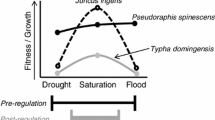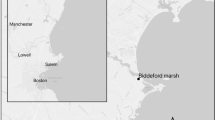Abstract
Resource availability is often characterized by mean annual amounts, while ignoring the spatial variation within habitats and the temporal variation within a year. Yet, temporal and spatial variation may be especially important for identifying the source of stress in low productivity environments such as deserts where resources are often pulsed and resource renewal events are separated by long periods of low resource availability. Therefore, the degree of stress will be determined in part by the length of time between recharge events. Here, we investigated the effect of timing and total amount of water application on two congeneric pairs, each with a population from a low (desert) and a high (Mediterranean) productivity habitat. As expected, highest survival and greatest growth were found at low or intermediate recharge intervals, and the magnitude of response to increases in total seasonal amounts was greater for Mediterranean species than desert species. The species that had greater survival switched in the hierarchy under high total water depending on interval length. These results demonstrate that temporal variation in resource availability can be as important as annual total amounts for plant performance and that response to temporal dynamics can vary between species. This has implications for community-level processes, as competitive hierarchies may switch based on resource dynamics rather than only total availability.




Similar content being viewed by others
References
Alpert P, Simms EL (2002) The relative advantages of plasticity and complexity in different environments: when is it good for a plant to adjust? Evol Ecol 16:285–297
Aronson J, Kigel J, Shmida A, and Klein J (1992) Adaptive phenology of desert and Mediterranean populations of plants grown with and without water stress. Oecologia 89:17–26
Bilbrough CJ, Caldwell MM (1997) Exploitation of springtime ephemeral N pulses by six Great Basin plant species. Ecology 78:231–243
Bowman WD (1992) Inputs and storage of nitrogen in winter snowpack in an alpine ecosystem. Arct Alp Res 24:211–215
Cable DR (1969) Competition in the semidesert grass-shrub type as influenced by root systems, growth habits, and soil moisture extraction. Ecology 50:27–38
Campbell BD, Grime JP (1989) A comparative study of plant responsiveness to the duration of episodes of mineral nutrient enrichment. New Phytol 112:261–267
Chapin FS (1991) Integrated responses of plants to stress: a centralized system of physiological responses. Bioscience 41:29–36
Danin A (1996) Plants of desert dunes. Springer, Berlin Heidelberg New York
Donovan LA, Ehleringer JR (1994) Water stress and use of summer precipitation in a Great Basin shrub community. Funct Ecol 8:289–297
Donovan LA, Mausberg J, Ehleringer JR (1993) Seedling size and survival for Chrysothamus nauseosus. Great Basin Nat 53:237–245
Easterling DR, Meehl GA, Parmesan C, Changnon SA, Karl TR, Mearns LO (2000) Climate extremes: observation, modeling, and impact. Science 289:2068–2074
Ehleringer JR, Phillips SL, Schuster WSF, Sandquist DR (1991) Differential utilization of summer rains by desert plants. Oecologia 88:430–434
Evenari M, Shanan L, Tademor N (1982) The Negev: challenge of a desert, 2nd edn. Harvard University Press, Cambridge, Mass.
Fay PA, Carlisle JD, Knapp AK, Blair JM, Collins SL (2000) Altering rainfall timing and quantity in a mesic grassland ecosystem: design and performance of rainfall manipulation shelters. Ecosystems 3:308–319
Feinbrun-Dothan, N. (1986) Flora Palaestina, part four. The Israel Academy of Sciences and Humanities, Jerusalem
Gebauer LE, Schwinning S, Ehleringer JR (2002) Interspecific competition and resource pulse utilization in a cold desert community. Ecology 83:2602–2616
Goldberg DE, Novoplansky A (1997) On the relative importance of competition in unproductive environments. J Ecol 85:409
Grime JP (1979) Plant strategies and vegetation processes. Wiley, Chichester
Grime JP (2001) Plant strategies, vegetation processes and ecosystem properties. Wiley, Chichester
Knapp AK, Smith MD (2001) Variation among biomes in temporal dynamics of aboveground primary production. Science 291:481–484
Knapp AK, Fay PA, Blair JM, Collins SL, Smith MD, Carlisle JD, Harper CW, Danner BT, Lett MS, McCarron JK (2002) Rainfall variability, carbon cycling, and plant species diversity in a mesic grassland. Science 298:2202–2205
Lodge DJ, McDowell WH, McSwiney CP (1994) The importance of nutrient pulses in tropical forests. Trees 9:384–387
Miao SL, Bazzaz FA (1990) Responses to nutrient pulses of two colonizers requiring different disturbance frequencies. Ecology 71:2166–2178
Nilsen ET, Sharifi MR (1997) Carbon isotopic composition of legumes with photosynthetic stems from Mediterranean and desert habitats. Am J Bot 84:1707–1713
Novoplansky, Goldberg (2001a) Effects of water pulsing on individual performance and competitive hierarchies in plants. J Veg Sci 12:199–208
Novoplansky A, Goldberg DE (2001b) Interactions between neighbor environments and drought resistance. J Arid Environ 47:11–32
Noy-Meir I (1973) Desert ecosystems: environment and producers. Annu Rev Ecol Syst 4:25–51
Reynolds JF, Kemp PR (2002) Shrub-grass transitions in the Jornada Basin in the past century: experimental and modeling evidence do no support climate hypotheses. Presentation. Pulse Workshop, ESA, Tempe, Ariz. (http://ag.arizona.edu/research/schwinn/WStalks.html)
SAS (1990) SAS/STAT user’s guide. SAS Institute, Cary, N.C.
Schwinning S, Ehleringer JR (2001) Water use trade-offs and optimal adaptations to pulse-driven arid ecosystems. J Ecol 89:464–480
Sternberg M, Shoshany M (2001) Aboveground biomass allocation and water content relationships in Mediterranean trees and shrubs in two climatological regions in Israel. Plant Ecol 157:173–181
Taub DR, Goldberg D (1996) Root system topology of plants from habitats differing in soil resource availability. Funct Ecol 10:258–264
Tilman D (1982) Resource competition and community structure. Princeton University Press, Princeton, N.J.
Volis S, Mendlinger S, Ward D (2001) Differentiation in populations of Hordeum spontaneum Koch along a gradient of environmental productivity and predictability: plasticity in response to water and nutrient stress. Biol J Linn Soc 75:301–312
Volis S, Mendlinger S, Ward D (2002) Adaptive traits of wild barley plants of Mediterranean and desert origin. Oecologia 133:131–138
Welzin JF, McPherson GR (2000) Implications of precipitation redistribution for shifts in temperate savanna ecotones. Ecology 81:1902–1913
Zohary M (1972) Flora Palaestina, part two. The Israel Academy of Sciences and Humanities, Jerusalem
Acknowledgements
We would like to thank Karen Vitkay and Shi Qian for technical help. Shachar Shem-Tov and Laurie Flowers provided invaluable comments on this manuscript, and it was much improved by edits from two anonymous reviewers. Thanks also to Cindy Tejral of the Denver Botanic Gardens for proofing the manuscript. This research was funded by the Fulbright Foundation (US-Israel) and the Blaustein International Center for Desert Research (Ben Gurion University of the Negev, Israel). This is publication no. 398 of the Mitrani Department of Desert Ecology, Ben Gurion University of the Negev.
Author information
Authors and Affiliations
Corresponding author
Rights and permissions
About this article
Cite this article
Sher, A.A., Goldberg, D.E. & Novoplansky, A. The effect of mean and variance in resource supply on survival of annuals from Mediterranean and desert environments. Oecologia 141, 353–362 (2004). https://doi.org/10.1007/s00442-003-1435-9
Received:
Accepted:
Published:
Issue Date:
DOI: https://doi.org/10.1007/s00442-003-1435-9




